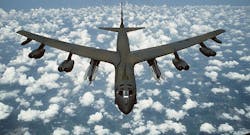Air Force asks Boeing to integrate next-generation nuclear cruise missile on B-52 bomber in $250 million deal
Officials of the Air Force Nuclear Weapons Center at Eglin Air Force Base, Fla., are asking the Boeing Defense, Space & Security segment in Oklahoma City, Okla., to integrated the nuclear-capable Long-Range Stand-Off (LRSO) cruise missile weapon system aboard the B-52.
Lockheed Martin Corp. and Raytheon Co. are competing to produce the next-generation nuclear-capable LRSO cruise missile, which is to replace the Air Force's 1980s-vintage AGM-86 air-launched cruise missile.
Boeing will develop aircraft and missile carriage hardware and software, as well as modify, test, and support integrating the future LRSO cruise missile aboard the Air Force's fleet of 76 B-52H bombers. The LRSO is expected to be ready for deployment around 2030.
Related: Navy moves forward on common missile compartment for future U.S. and U.K. nuclear submarine
When the new nuclear-capable cruise missile is ready, it will be deployed aboard the B-52H, as well as the B-2 Spirit and future B-21 Raider strategic bombers.
The eight-engine B-52 has been in service since 1955, and was developed originally as a long-range bomber to deliver nuclear weapons worldwide. In recent years surviving and modernized versions of the B-52 have been upgraded to carry a wide variety of conventional munitions. The old AGM-86 subsonic nuclear cruise missile was designed in 1974, and production began in 1980.
On this contract Boeing will do the work in Oklahoma City, Okla., and should be finished by December 2024. For more information contact Boeing Defense, Space & Security online at www.boeing.com/company/about-bds, or the Air Force Nuclear Weapons Center at www.kirtland.af.mil/Units/Air-Force-Nuclear-Weapons-Center.
Ready to make a purchase? Search the Military & Aerospace Electronics Buyer's Guide for companies, new products, press releases, and videos
